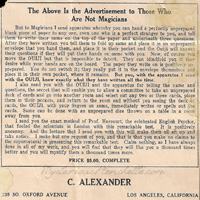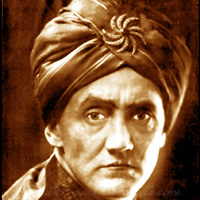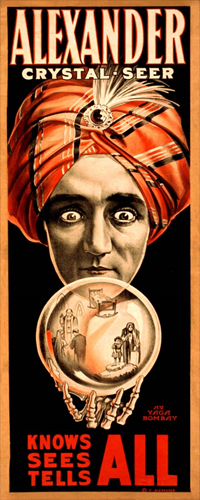Claude Alexander Conlin was one of the most successful and highest-paid magicians of his era, earning millions between 1915 and his retirement in 1924. Performing under the name "Alexander," often with a "Crystal Seer" or "The Man Who Knows" moniker attached, his act centered around his famed psychic abilities as a mind reader, answering sealed questions and performing other astonishing feats of mentalism. To further bolster his mystical image, he dressed in the image of the classic swami, with oriental robes and a bejeweled turban, often using a crystal ball as a prop.
Alexander had a paradoxical relationship with Spiritualism and the occult. In 1921, for example, he authored "The Life And Mysteries Of The Celebrated Dr. Q," which--like Houdini and Dunniger--exposed the fraudulent means by which mediums duped seance sitters, revealing their tricks, props, and secrets. But his publishing house, C. Alexander Publishing Company, also published a wide array of occult and spiritualist books beginning in 1919, with titles featuring, among other topics, guides to mediumship, astrology, psychic phenomena, and New Thought philosophies. His firm also offered seance props, and advertisements exist for a "Dr. Q" line of rapping hands, seance trumpets, and spirits slates--most produced by Thayer. But Alexander produced his own items, too, and about this period took advantage in the upsurge of popularity in Ouija boards, undergoing their usual post-war revival, as his publishing house produced a talking board and planchette of its own. The confusing paradox continued with such products; on the one hand, he sold some devices as genuine spirit communication tools, yet they often contained brochures for additional information--at an additional cost--on how to turn the items into props for magic tricks for professional magicians.
Though he named this product "Alexander's Original Luminous Ouiji Divining Board," it actually incorporated an automatic writing planchette. The devices are exceedingly rare, as they were not sold in bookshops and were only available direct from Alexander, meaning that distribution and sales were likely very limited. To date, we've never seen a surviving copy. Thankfully, the detail which Alexander describes the device allows us to reconstruct a reasonable facsimile, which we provide here in hopes of raising awareness of the possibility of their rediscovery.
Alexander's trade circulars describe the item as made of 3-ply finished hardwood. The topside was pasted with the classic picture of Alexander's turbaned-head and piercing eyes, in much the same manner as the Chad Valley "Hand of Fate" boards of the period. This five-color lithograph may very likely have been cut from the enormous amount of excess posters Alexander had produced from his years of touring, as we know that so many remained in his possession after his death that when the magician Mandrake purchased them from the estate, he was able to use them on his own tours for years afterward. Given this excess of material, it is highly likely that the planchettes were made from this stock of leftover lithographs, and period engravings of the device seem to indicate the same design style.

Ouiji board brochure, appealing to magicians to send in for additional apparatus that would convert the board into a magic trick of mentalism.
The writing set came complete with a light green lithographed fortune sheet pasted to a framed board, similar to the Wheeler Wireless Messenger talking boards. Notably, the ads describe either the board or planchette as having a central circle of luminous paint, undoubtedly of radium paint used to paint glow-in-the-dark watch dials of the era. One would hope that the promise of the glowing paint "lasting for years" is equal consolation for its carcinogenic properties. Any information on these items is greatly appreciated, and if you have anything to contribute to our research on this fascinating device, please contact the curator!








